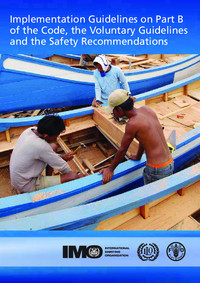
Implementation Guidelines on Part B of the Code, the Voluntary Guidelines and the Safety Recommendations
Introduction
- Fishing continues to be recognized as one, if not the most, hazardous occupation in the world. In 1999, it was estimated that there were 24000 deaths annually, the large majority of these on board small vessels. At the time of the preparation of these Implementation Guidelines, it was also estimated that there were some 4 million fishing vessels operated globally, 1.3 million decked vessels, of which probably 96 percent were less than 24 m in length, and 2.7 million undecked vessels, of which at least 1.7 million were not mechanically powered, indicating the importance of taking action to improve safety of these smaller vessels.
- The fishing industry is characterized by the lack of a safety culture; There are many factors that have led to this, earnings only linked to the catch; Training, education, poverty, outdated legislation and the perceived high cost of safety in an industry that is suffering declining catch rates and over increasing higher input costs. The introduction of a regulatory framework is but one of the faucets to inculcate a safety culture; ̎the most effective and long lasting change will only occur when the industry itself embraces the need for a safety culture that has eluded it for so long ̎.
- A part from having in place a regulatory framework, there are other actions that can be considered as part of an overall safety programme. For example, there should be both high-level and community –based safety seminars focusing on safety awareness, the raising of training and educational levels, and addressing minimum levels of manning for different classes and types of fishing vessels.
- The cooperation and coordination between maritime and fisheries administrations is important, particularly where the responsibilities for safety of fishing vessels are divided relevant Acts. In addressing stock management issues, decisions made should also consider the possible resultant impact on safety in the fisheries.
- Valuable lessons on how to improve ergonomics can be gained from other sectors and from experts in occupational safety and health and related disciplines. The administration(s) responsible for improving vessel and crew safety should seek, where practicable, to draw upon such knowledge and experience when seeking to improve fishing vessel design and when overseeing installation of new equipment. The importance of making vessels not only safe but also healthy and tolerable for crews should not be overlooked.
- Therefore, the purpose of these Implementation Guidelines is to assist maritime administrations and/or fisheries ministries to put in place, or refine, a regime that will give effect to Part B of the Code, the Voluntary Guidelines, and the Safety Recommendations, from a practical perspective. In order to ensure a holistic approach, these Implementation Guidelines include subjects such as operational safety and the human element, and the reader’s attention is also drawn to the Code of Safety for Fishermen and Fishing Vessels, Part A. These Implementation Guidelines cover such areas as:
- development of a safety strategy
- legal implications
- administrative requirements
- capacity building
- training of crew members
- enforcement of regulations
- operational safety
7. Any reference in these Implementation Guidelines to “the instruments” means the Code of Safety for Fishermen and Fishing Vessels, Part B, the Voluntary Guidelines for the Design, Construction and Equipment of Small Fishing Vessels and the SafetyRecommendations for Decked Fishing vessels of Less than 12 metres in Length and Undecked Fishing Vessels.
8. Terms used in these Implementation Guidelines have, in general, the same meaning as those used in the instruments.
Contents
Chapter 1: The instruments
Chapter 2: Administrative requirements
Chapter 3: Legal implications
Chapter 4: Capacity building
Chapter 5: Ensuring compliance with national requirements
Chapter 6: Operational safety
Chapter 7: Common understanding of the technical provisions and terminology of the instruments
Chapter 8: Human element on board



ساحة النقاش